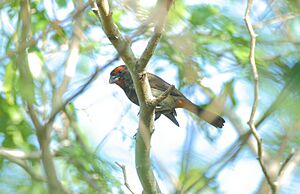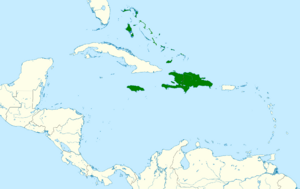Greater Antillean bullfinch facts for kids
Quick facts for kids Greater Antillean bullfinch |
|
|---|---|
 |
|
| M. v. affinis, Dominican Republic | |
 |
|
| M. v. ruficollis, Jamaica | |
| Conservation status | |
| Scientific classification | |
| Genus: |
Melopyrrha
|
| Species: |
violacea
|
 |
|
| Synonyms | |
|
|
The Greater Antillean bullfinch (Melopyrrha violacea) is a cool little bird found in the Caribbean. It belongs to the Thraupidae family, which includes many different kinds of tanagers and finches. This bird is known for its dark, often purplish feathers.
Where It Lives and Its Home
This bullfinch makes its home across several islands in the Caribbean. You can find it in the Bahamas, Hispaniola (which includes the Dominican Republic and Haiti), Jamaica, and the Turks and Caicos Islands.
It likes to live in different kinds of forests. These include dry forests, moist lowland forests, and even moist mountain forests. It can also be found in dry shrubland areas. Sometimes, it even lives in places where forests have been changed a lot by people.
About Its Name
The Greater Antillean bullfinch got its official scientific name, Loxia violacea, in 1758. This name was given by a famous Swedish scientist named Carl Linnaeus. He is known for creating the system we use today to name living things.
The word violacea comes from Latin. It means "violet-coloured," which describes the bird's dark, purplish feathers. Linnaeus learned about this bird from an earlier description and drawing by Mark Catesby.
Over time, scientists learned more about birds through new studies. Because of this, the Greater Antillean bullfinch's scientific name was changed. It moved from the Loxigilla group to the Melopyrrha group. The Puerto Rican bullfinch also moved to this new group.
Different Types of Greater Antillean Bullfinches
Scientists have found five different types, or subspecies, of the Greater Antillean bullfinch. These subspecies are slightly different from each other, often based on where they live.
- M. v. violacea (Linnaeus, 1758) – This type lives in the northern and central parts of the Bahamas.
- M. v. ofella (Buden, 1986) – You can find this one in the central and eastern Turks and Caicos Islands, and the southern Bahamas.
- M. v. maurella (Wetmore, 1929) – This subspecies lives on Tortue Island, which is off the northwest coast of Hispaniola.
- M. v. affinis (Ridgway, 1898) – This type is found across Hispaniola and the islands nearby.
- M. v. ruficollis (Gmelin, JF, 1789) – This subspecies lives only on the island of Jamaica.


